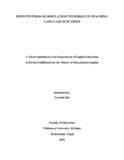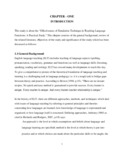Please use this identifier to cite or link to this item:
https://elibrary.tucl.edu.np/handle/123456789/3354| Title: | Effectivenessof Simulation Technique in Teaching Language Functions |
| Authors: | Rai, Govinda |
| Keywords: | Teaching Language;Techniques |
| Issue Date: | 2010 |
| Institute Name: | Central Department of Education |
| Level: | Masters |
| Abstract: | The present study entitled “Effectiveness of Simulation Technique in Teaching LanguageFunctions” endeavors to find out the effectiveness of simulation in teaching languagefunctions at secondary level and aims at suggesting some pedagogical implications.Tothisend, Ipurposively selected a government school,Gokundeshwor Higher SecondarySchoolfrom Dhankuta district. In order to collect data,both the primary and secondarysources were used. Twenty studentsofGrade IX whowere selected by using simplerandomsampling procedure, were involved in this study. The students were divided intotwo groups’experimentalgroupand controlledgroup. The main tools for data were testitems. A pre-test was administered before students were divided into two groups. Boththe groups were taught for 25 days.The experimental group was taught by usingsimulation technique and the controlled group was taught as usual classroom techniques.After experimental teaching, the post-test was administered by using the same sets oftestitems that were administered in the pre-test. After analysis and interpretation of the data,the experimentalgroup which was taught by using simulation excelled the controlledgroup by 27.73% in functional category and 29.93% in item category holistically. Thus,Ican saythat the simulation technique was more effective, interactive and interesting thanusual classroom techniques like discussion and lecture. The thesis has been divided into four chapters. The first chapter consists of thebackgroundof the study, review of the related literature and objectives of the study.Chapter two deals with the methodology adopted for the study under which the sources ofdata, sampling procedures, tools for data collection, process of data collection andlimitationsof the study are presented. Likewise,chapter three presents the analysis andinterpretation of the collected data. In this section,both the statistical as well asdescriptive approaches have been used. Finally, the presentresearchsummarizes thewhole study by presenting findings and suggesting some recommendations. Thereferences and appendices form the concluding part of the thesis. |
| URI: | http://elibrary.tucl.edu.np/handle/123456789/3354 |
| Appears in Collections: | English Language Education |
Files in This Item:
| File | Description | Size | Format | |
|---|---|---|---|---|
| cover page.pdf | 28.9 kB | Adobe PDF |  View/Open | |
| chapter.pdf | 316.24 kB | Adobe PDF |  View/Open |
Items in DSpace are protected by copyright, with all rights reserved, unless otherwise indicated.
